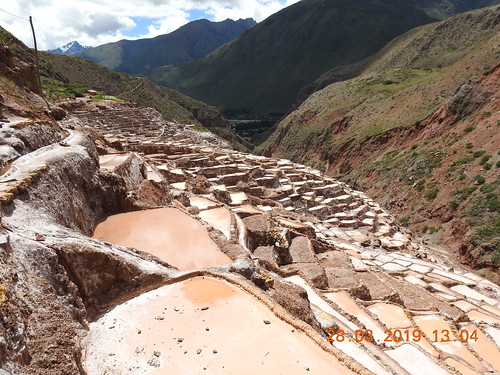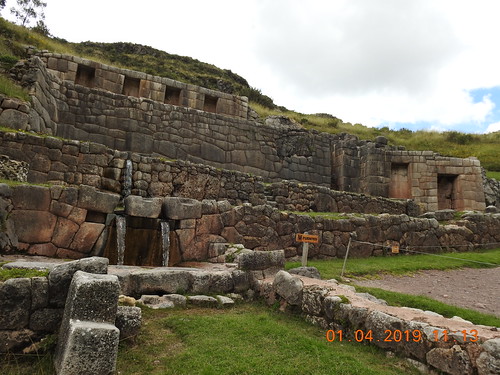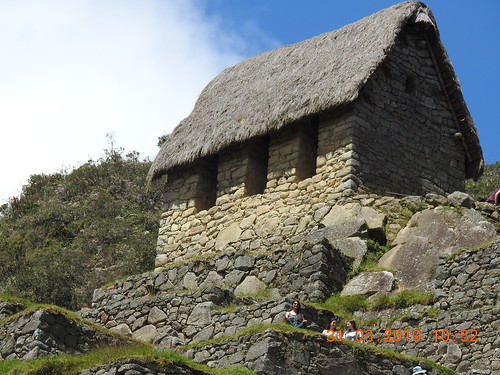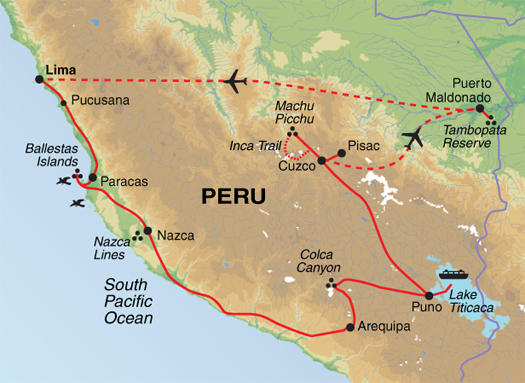
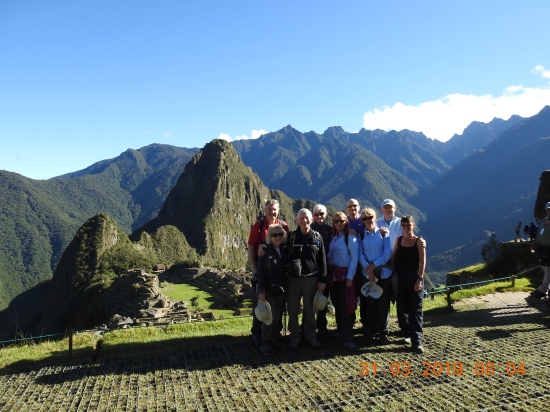
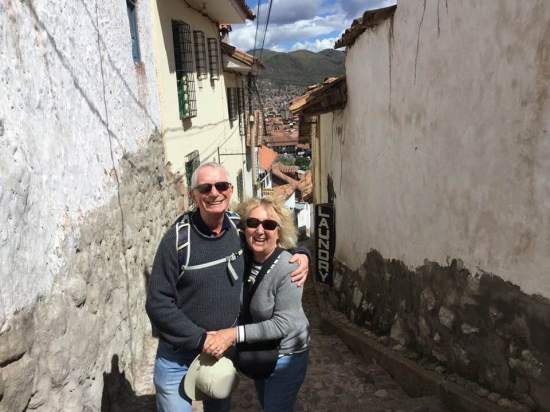
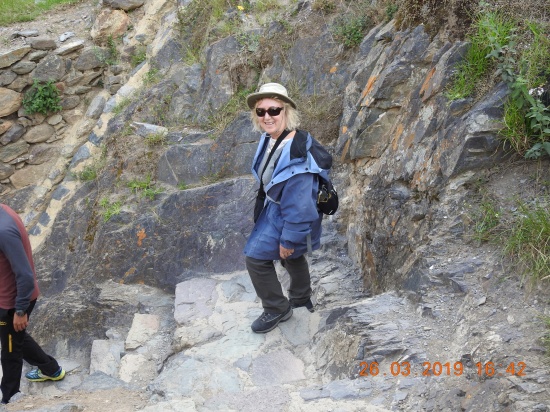
This blog describes the third stage of our anticlockwise, circular, adventure, journey around Peru. Stage 1 was Exploring Lima & Peru’s Desert Wonderland, and stage 2 Exploring South Pacific Ocean to Lake Titicaca, Peru. Here we focus on stunning Cusco and breathtaking Machu Picchu .
Day 11, we left Puno & Lake Titicaca, and drove across the altiplano to Cusco (3400m) – altiplano are the high plains, separating the Andes from Amazonia. The ten-hour drive had fabulous views. One of the many stops en route to Cusco was at the La Raya Pass (4313m), the watershed and geographical dividing line between the altiplano and the Vilcanota Valley where Raqchi Inca temple is located. We arrived in Cuzco early evening. We were staying a few streets from the cathedral.
Day 12, we left Cusco, stopping at the colourful handicraft market at Pisac, at the entrance to the Sacred Valley of the Incas. We walked around the huge Inca ruins above the village. Later we had a traditional ‘pachamanca‘ lunch – food is wrapped up and buried in the earth with hot stones, so that it’s cooked slowly. It was cooked using the ancient method of digging a square hole and using hot stones as a heating element, layer by layer vegetables, herbs and more hot stones, adding damp cloths for moisture, then covering with earth – lastly, saying a prayer to Mother Earth, asking permission to eat the food! It comprised of chicken, beef, potatoes and beans and was truly delicious! In the afternoon, we drove down the valley to Ollantaytambo where we visited the immense Inca fortress and explored the unique village and ancient narrow streets, just like in Inca times. We spent the night in Ollantaytambo.
Day 13, before returning to Cusco, we took a leisurely early morning walk around the amazing and ancient alleyways of Ollantaytambo. In the afternoon, we managed to squeeze in a two hour visit to the Machu Picchu Museum, Cusco – The museum is organized around a collection of historic artifacts, taken during Hiram Bingham‘s famous excavation in 1912, and finally returned by Yale University in 2011. This small museum is very highly recommended.
Today our group split into one person doing the Inca Trail and eight others essentially having three days free time in Cusco. The Cusco site was the historic capital of the Inca Empire from the 13th until the 16th-century Spanish conquest. In 1983 Cusco was declared a World Heritage Site by UNESCO with the title “City of Cuzco”. It’s one of the World’s top tourist destinations, hosting nearly 2 million visitors a year. Cusco is a delightful, colourful and cosmopolitan city. Whilst there’s a lot of touting for a massage in the main square, generally standards are high, with comfortable hotels, good restaurants and plenty of cafes etc. Our three days flashed by, with visits to:
- Main squares, including Plaza De Armes, Plaza Regocijo, Plaza San Francisco and Plaza Limacpampa Chico
- Historic churches, including La Catedral, San Cristobal, San Blas, San Francisco and Santo Domingo – built by the Spanish on top of one of the Inca’s most important sites
- A selection of the many museums, including Machu Picchu Museum, Cusco and Museo de Arte Precolombino (exhibits included pottery, silver and gold, prior to the Incas)
- Some typical restaurants, with our favourite being the Cicciolina Restaurant, a tapas bar and restaurant, with an excellent seleection of Malbec red wines from Argentina.
We had hoped to do some hiking in the hills around Cusco but decided against it – it was too urbanized for us.
Day 16, we left Cusco for our visit to Machu Picchu. We drove to Ollantaytambo again and then took the 90 minute scenic train journey through the Urubamba River Valley to Aguas Calientes, arriving mid afternoon. It was raining hard when we arrived and we were a bit worried about about the weather for our visit to Machu Picchu, the next day. We had chosen the end of the rainy season to avoid the crowds, understanding that the whole area is seriously overrun with tourists in the Summer months (June, July and August)). Despite the rain, we explored the bustling town of Aguas Calientes – it reminded us of ski-resort in peak season.
Day 17, we visited the ancient site of Machu Picchu. To our delight, the rain had cleared, it was a blue sky, with strong sunlight. We left our hotel at 7.00AM and took the official bus up the mountain, a thirty-minute trip on a very windy road to the site entrance.
Machu Picchu is regarded as one of the architectural and engineering marvels of the ancient world, with unbeliebably stunning mountain backdrop. Amazingly, the Spaniards did not find it in their quest for gold. It was essentially lost, overgrown by hundreds of years of jungle. It was rediscovered by Hiram Bingham, in 1911, at that time an Associate History Professor at Yale University. Machu Picchu is an Incan citadel, built in the 15th century, later abandoned ahead of the Spanish invasion. It’s renowned for its sophisticated dry-stone walls that fuse huge blocks without the use of mortar, intriguing buildings that play on astronomical alignments and panoramic views. It’s former use is still not clear, with many diverging theories.
We spent four amazingly hours walking the archaelogical site – there are very strict allocations of time on site. It’s important to understand that it’s quite rugged, with steep ups and downs. We felt like we had been hiking at the end. It’s impossible to describe the beauty and the amazing archectecture. Probably, it’s best to refer you to our photos – see the link below. Better still, visit yourself but try to avoid the crowds.
We caught the afternoon train back to Ollantaytambo and continued by private bus to Cuzco, circa four hours in total. We returned to the same room in the same comfortable hotel, showered then celebrated, with some late evening tapas and ‘tinto’ – yes, we went to our favourite ‘tapaserie’!
Day 18, our group had a full-day of touring, both Cuzco and visiting the Inca fortress of Sacsayhuaman – this was the fortress where the Inca armies made their last stand against the Conquistadores.
Day 19 was yet another free day in Cuzco.
Day 20 we flew to Amazonia, for stage 4 of our Peruvian adventure trip but that’s the focus of the next blog.
To view our photos, tap on the appropriate photo below and press the right arrow, choosing between:
- Sacred Valley
- Cusco
- Maschu Picchu
